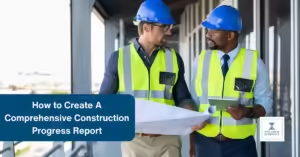When managing construction, general contractors and project managers must keep track of a million moving parts to ensure the project’s quality and timely completion. Even before construction starts, one critical thing to do is set project baselines. These baselines help you keep track of your work, make changes as needed, and still finish your projects on time and budget. It provides valuable insights into what is deviating from the original plan by letting them compare real progress to the plan.
In this article, we will discuss project baselines in more depth, including their definition, how to set them, and why they are crucial to efficient and effective project management. We will also discuss the common challenges you may encounter in creating and tracking your project baselines.
Defining A Project Baseline
A project baseline is a plan you define and create with all relevant stakeholders during the project’s early planning stages. It lays out the project’s goals and deliverables, such as the schedule, scope, and cost, as a reference throughout its progress and duration.
It is the precise starting point for your project plan, where you can measure and compare your progress. Baselines provide you valuable insights into how well your project is doing and if you need to change or adjust something in your processes to hit your targets and milestones.
It could be as simple as a short list of estimated costs, times, and due dates or a more detailed document with a list of goals or budget estimates for each project stage.
For example, let us say that your project will be completed in around eight weeks. Are you on track, or is your project delayed? With baselines, you can tell if your project faces roadblocks or potential delays. You can tell there is a problem if your schedule baseline says it should be completed in four weeks or if your project is on track to be done in six weeks. This way, you can evaluate your project and see which areas need to be streamlined.
Parts of A Project Baseline
A project baseline has three parts – namely, the schedule, the cost, and the scope. These are the three main parts that can make or break a project’s success, and each one is meticulously tracked, controlled, and reported on its own to ensure it stays on track. It could be called a performance measurement baseline (PMB) when fully merged.
Let us further define the three parts of a project baseline.
Schedule Baseline
As you plan your project, a schedule defines your targets and milestones. It shows the target completion dates of every activity and how they affect the project’s overall completion. You can use the baseline plan to find and fix scheduling problems with any project team, person, or process before, during, or after the project.
Scope Baseline
Several project documents make up the scope baseline. These documents list the different deliverables and standards that the project should meet. The scope of a building job could be to lay the foundation and then build a new building that meets specific standards. Using a work breakdown structure (WBS) allows you to break down your scope into particular tasks based on deliverables.
Cost Baseline
The project cost baseline is the last form of the budget for the project before it starts. As changes are made to the budget, the baseline will show how good your study was in the initial planning phases. If you can predict costs better, you can make better project management decisions in the future.
Benefits of Having Project Baselines
There are many perks to having a baseline. From keeping track of your project’s progress to letting you know if you are still on schedule and within budget, project baselines allow you to see a clear overview of the project and see if it is progressing according to plan. You can avoid project failure, cost overruns, and project plan changes.
In this section, let us look at the benefits of a project baseline.
Better Estimates
Being able to compare your actual cost, schedule, or scope to a baseline can help you see where a project has failed or succeeded. You can then use what you have learned to make better job plans and estimates in the future.
Better Performance Evaluations
As stated in the previous sections, a baseline allows you to compare how far along a job is. It is easier to measure how well different projects are done with one.
Better Profitability
Project baselines allow you to see how your project’s success compares to your plan. But they are more than just a simple way to rate success. They also let you look at project trends and guess if a project will have problems in the future.
What You Will Need to Create a Project Baseline
Usually, you will need to collate the following essential things to make a project baseline:
Project Scope Document
First, when making a scope baseline, you will need an official scope statement that lists the project’s goals and needs. This should be discussed with the client, contractor, and all relevant stakeholders to ensure the project’s deliverables are captured in the document. This will also serve as the starting point for knowing what needs to be done.
Work Breakdown Structures
As mentioned earlier, work breakdown structures (WBS) list all the smaller tasks needed to complete the project. With these, general contractors and project managers can easily see what work needs to be done to reach the project goals.
Master and Project Schedules
It would help if you defined your master and project schedules to start any project. This is a list of dates for when each job or work package should begin and end.
Cost Breakdown Structure
To get a cost baseline, you will need an idea of how much each job will cost in terms of labor, materials, equipment, and other costs. You will also need a list of the people, tools, and materials required for each job. You can use crew scheduling software to plot your crew’s schedule and get an overview of your project’s productivity timeline and completion.
Approval From Stakeholders
You must show your project baselines to the people who matter most, like your stakeholders. These people could be the project managers, clients, team members, or trade partners. Everyone must agree with the baselines and secure their approval before using it.
Construction Management Software
With today’s digital advancements, there are a lot of construction technologies that contractors can take advantage of, depending on their organization’s needs. Construction management software can offer powerful features to help you simplify your tasks, whether it is construction employee scheduling or inventory management. This will make it easier to create, share, and keep project plans, schedules, and budgets up to date and compare them to the starting point.
Setting a Project Baseline
Once these things are in place, you can start setting your official project baselines. After that, you can use these as a guide to see how far you have come and how any changes to the original plan have affected things.
Make the Initial Drafts of Your Project Baselines
When you make an initial project charter, you should be able to list the project’s purpose, goals, and essential partners. It should include a summary of the project’s objectives, main deliverables, projected cost, and due date that was agreed by the stakeholders early on in the project.
Make Sure All Stages and Milestones are Clear
Now is the time to check each job step and ensure everything is in order. Does the project’s flow make sense? Do you need to go into more depth? Try to include more broad stages, such as study, design, prototyping, and more. Then, list a few logical steps that need to be taken in each part.
Add Contingencies For Your Budget and Schedules
Making correct baselines often means being ready for the unexpected. After making a first plan with steps and deadlines, add extra time in case of problems, delays, or roadblocks. Add additional money to your project budget to cover costs you didn’t plan or could not avoid. This will help you stay within your budget and avoid going over.
Continuously Update Your Baselines As Your Project Progresses
Most of the time, you will not need to or want to change the original baseline for shorter or smaller jobs. But if you are working on more complex projects or that will last more than one year, the market may change significantly, which affects your project’s goals. That means the original baseline will show a different project, and you’ll need to change it to a new baseline that better shows your project goals.
Common Challenges You Can Encounter With Inaccurate Project Baselines
When there are no substantial project baselines, you might face a few problems as your project progresses. In this section, let us look at the common issues you may encounter.
Additional Resources Required
You may require more resources than initially planned to complete the project. More resources often mean higher costs.
Schedule Delays
This could be caused by several problems, such as the wrong timing for buying things or delays in delivering materials. It is easier to ensure you order things on time if you know when you need them, especially if they need to be bought weeks or months ahead.
Quality Problems
A scope limit that needs to be clarified can lead to poor quality. For instance, if you know you need paint but need the right color or finish, the result might not meet the customer’s expectations.
Various Change Orders
Keeping track of and handling changes can be more difficult when no baselines exist. Since you do not have a standard to compare against, it can be hard to tell if the result differs from what you thought it would be.







